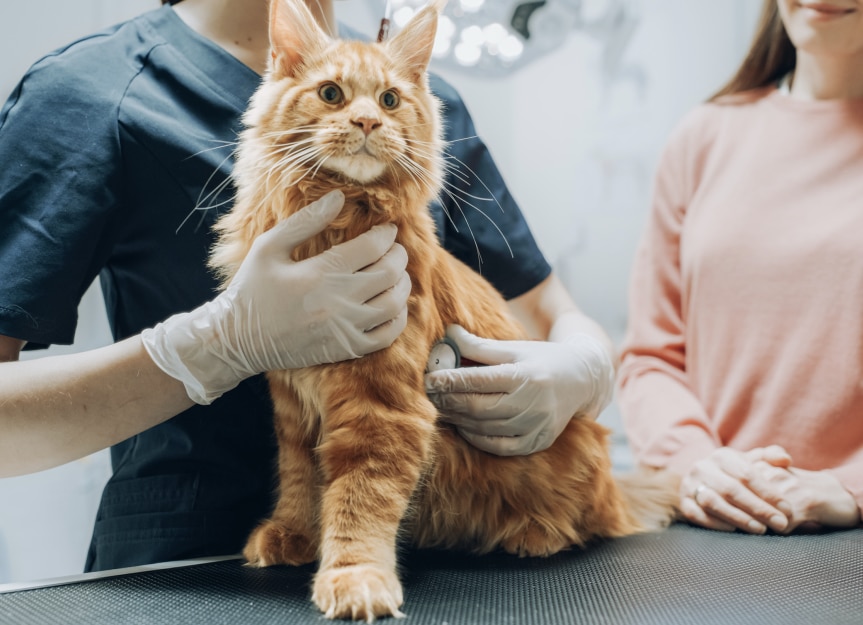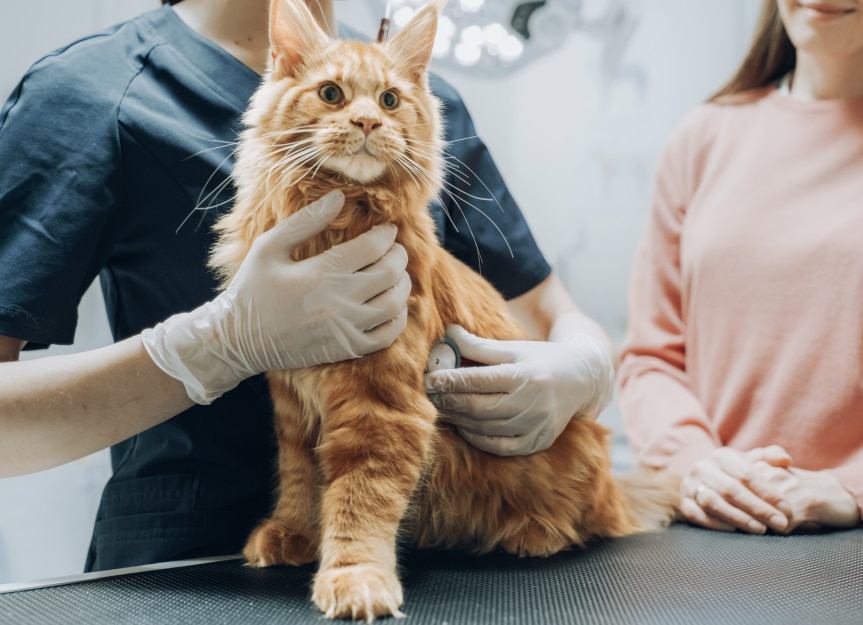
If your cat has a mass or tumor, cat tumor removal may be offered as a potential treatment option.
The diagnosis of a tumor can be a lot for pet parents to handle emotionally, and determining what is best for your cat may be challenging.
Here, you’ll learn what cat tumor removal surgery is, risks and benefits of the procedure, and cat tumor removal cost.
Key Takeaways
- Cat tumor removal is a common surgical procedure used to treat both benign and malignant tumors, potentially curing cancer and improving comfort.
- The surgery’s complexity, risk, and cost vary widely depending on the tumor’s location, size, and type—ranging from $500 to several thousand dollars.
- Post-surgery recovery involves pain management, limited activity, and careful wound monitoring, with sutures typically removed after 10–14 days.
- Not all tumors require removal; alternatives like monitoring, chemotherapy, radiation, or supportive care may be recommended based on the tumor and the cat’s overall health.
What Is Cat Tumor Removal?
Cat tumor removal is a surgical procedure to remove a mass, either benign or malignant (cancerous) from a cat’s body.
In some cases, this surgery can be curative for cancer. In other cases, the surgery can improve a cat’s comfort.
Tumor removal surgery is less common in cats than in dogs because cats tend to develop skin tumors less often than dogs.
However, this surgery is still considered a common procedure in cats.
How Does Cat Tumor Removal Work?
Veterinarians remove most tumors while cats are under general anesthesia.
In some cases, vets can sedate a cat and use local anesthesia to numb the area and remove a small skin tumor.
Tumors can form anywhere on the outside or inside of a cat’s body. Most tumors that vets remove are on or just underneath the skin, where it is relatively easy to remove the affected skin and close the area with sutures.
If the tumor is inside the body, surgery becomes more complex. Primary care vets can remove many abdominal tumor types, but those in the chest or brain require surgery with a specialist.
Why Would a Cat Need a Tumor Removed?
Both benign and malignant tumors may be removed.
Reasons to remove a benign tumor, which is a non-cancerous tumor type that will not spread or threaten overall health, include:
Malignant masses are cancerous, which means they have the potential to spread and affect other body organs and systems.
Examples of common malignant masses that may be surgically removed from cats include mammary (i.e., breast) tumors, fibrosarcoma, and squamous cell carcinomas.
Some malignant masses are too large or too complex to remove.
However, surgery is recommended if there is a good chance that removal will cure the cancer. If a mass is removed, it can also be sent to a lab for biopsy.
The biopsy will tell you what type of cancer is present, how aggressive it is, and the potential for spread or recurrence so you and your veterinarian can plan.
Risks of Cat Tumor Removal
All surgeries come with risks.
For cat tumor removal, risks include:
Anesthetic procedures also come with risk, which can include death in rare cases.
The risk of anesthetic death is around 0.11%, or 1 in 895, in seemingly healthy cats undergoing anesthesia. When cats die during or immediately after a surgical procedure, the most common reason is an undetected heart condition, such as feline hypertrophic cardiomyopathy (HCM).
Some tumor removal surgeries are riskier than others.
For example, removal of a small skin tumor is less risky than removal of a brain tumor. Your veterinarian will talk to you about your cat’s individual risk and recommend pre-anesthetic tests to minimize those risks.
Benefits of Cat Tumor Removal
The following are potential benefits of cat tumor removal:
If the tumor is sent for biopsy, your veterinarian can learn what type of tumor was present, if it was removed completely, and the potential for spread.
This information helps your veterinarian develop future treatment plans and lets them know how closely to monitor the area for recurrence.
Effectiveness of Cat Tumor Removal
Cat tumor removal is curative for most benign tumors, provided the entire tumor is removed and no microscopic tumor cells are left behind.
The success rate of tumor removal for cancerous tumors depends on the tumor type, size, location, and behavior.
For example, a tumor that is located on the side may be easier to remove than a tumor that is next to the genitals.
A tumor on the lower limb may require an amputation to remove it all, while a tumor on the cat’s back may only require a long incision.
Cost of Cat Tumor Removal
The cost of tumor removal in cats varies widely based on the tumor size, surgical difficulty, and where the procedure is performed.
Tumor removal may cost $500 or more, with costs quickly rising for complicated procedures. Skin or mammary tumor removal can cost about the same amount, but a complex procedure like brain tumor removal could cost several thousand dollars.
Preparing for Cat Tumor Removal
Tumor removal is a surgical procedure.
Your pet must fast beforehand to reduce the risk of vomiting and getting fluid into their lungs (aspirating) while under anesthesia.
A common recommendation is to withhold food after midnight the night before the procedure but allow your pet to freely drink water.
Follow your veterinarian’s specific recommendations regarding food and water. Also, ask them if you should give your cat any medications on the morning of the procedure.
Consider purchasing a recovery cone or recovery suit to prevent your cat from licking or traumatizing their incision after surgery.
Your veterinarian may also send you home with a rigid recovery cone.
Ensure you follow your veterinarian’s instructions for administering the medication to prevent breakthrough pain or medication side effects.
In most cases, you must restrict your cat’s activity for 10 to 14 days while their incision heals.
You should also keep the incision clean and dry. If you notice redness, swelling, pus, significant bleeding, or openings in your cat’s incision, contact your veterinarian immediately.
Use recovery cones or recovery suits to protect your cat’s incision, and consider placing soft beds in your cat’s favorite locations so they can rest.
External sutures can usually come out 10 to 14 days after surgery, but your veterinarian will set the timeline for rechecks and suture removal.
Alternatives to Cat Tumor Removal
Not all cat tumors require removal.
For benign tumors, it’s often OK to simply monitor the mass.
Benign masses should be removed only if they’re causing discomfort or affecting movement. However, keep in mind that the larger these masses become, the harder they are to remove.
For cancerous tumors, surgery may or may not be an option. Some tumors respond to radiation therapy, chemotherapy, or other targeted cancer treatments. These cancer treatments are more expensive than surgery alone, which may limit their use for many pet parents.
If surgery and other cancer treatments are not accessible for you, your veterinarian can prescribe pain medications, anti-nausea medications like Cerenia, and appetite stimulants like mirtazapine to help your cat remain comfortable.
Your cat’s life expectancy may be shorter if you elect pain management over cancer treatments; however, quality of life is more important than quantity.
There is no shame in electing supportive care to keep your cat comfortable and allowing them to continue enjoying life.
Cat Tumor Removal FAQs
How successful is tumor removal in cats?
Whether surgical removal of a cat tumor is successful depends on the tumor type, location, size, and behavior. Tumors that are larger, more aggressive, and cancerous are less likely to be entirely removed during surgery. Microscopic cells can remain behind that allow regrowth.
Some locations on the body are more surgically challenging than others.
Can a tumor be removed from a cat?
Some cat tumors, especially those on the skin, can be removed. Whether surgery is an option depends on the type and location of the tumor, its size, and how aggressive it is.
Is a tumor painful for cats?
Some tumors are painful for cats. Your veterinarian can prescribe pain medications if your cat has discomfort from their condition. Removing the tumor can address chronic pain, but your cat may experience post-operative pain that requires additional management.
How long can my cat live with a tumor?
Your cat’s life expectancy with a tumor depends on the type of tumor and how aggressive it is. Many benign tumors will not affect your cat’s overall lifespan. Cats can live from days to years with cancerous tumors, and removal may cure the cancer and extend lifespan in some cases. However, aggressive tumors can also significantly shorten your cat’s lifespan, even with removal.
What is the survival rate for a cat with a bone tumor?
Osteosarcoma, which is the most common type of bone cancer in cats, usually has a survival rate of six to 12 months with surgery and other treatments. Without treatment, life expectancy may be limited to several weeks after diagnosis.
Cats who undergo amputation surgery for osteosarcoma that is located on a limb and has not yet spread can survive two to four years.



